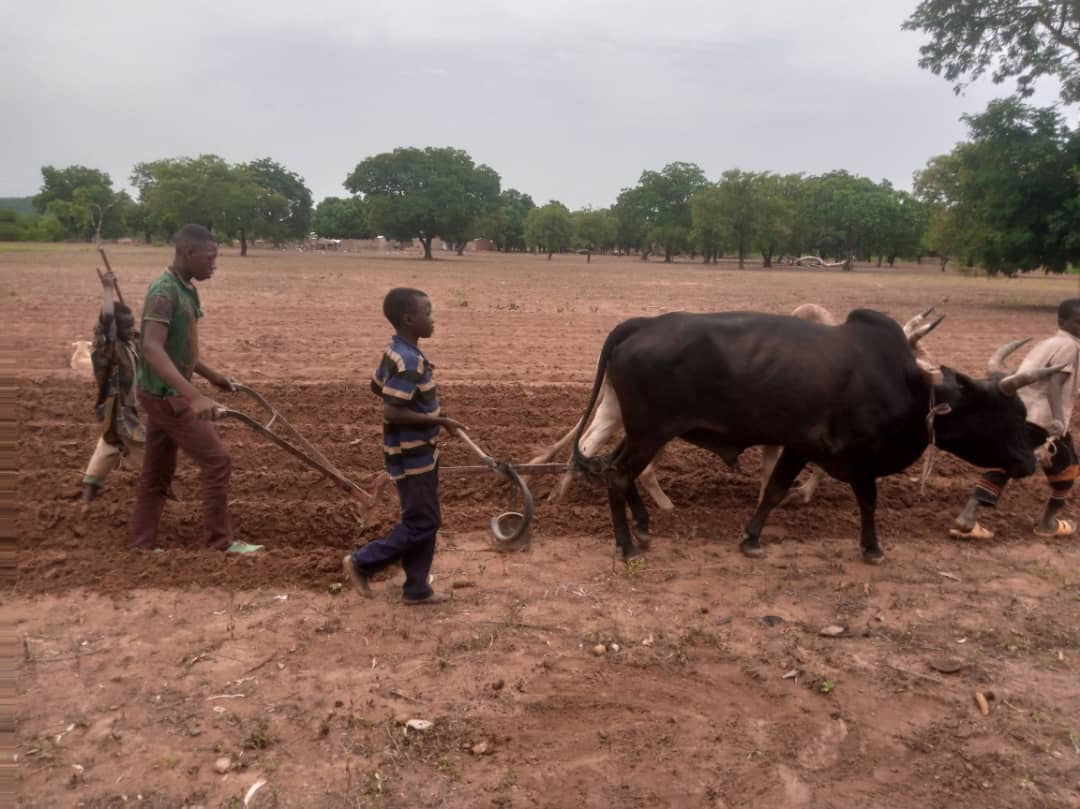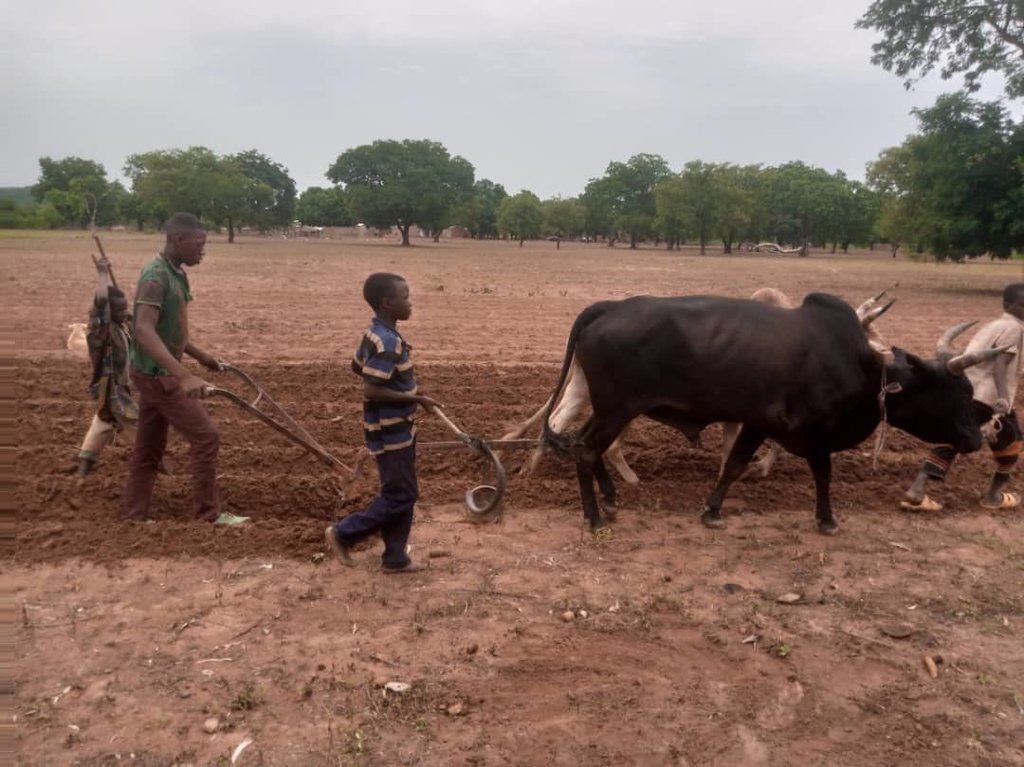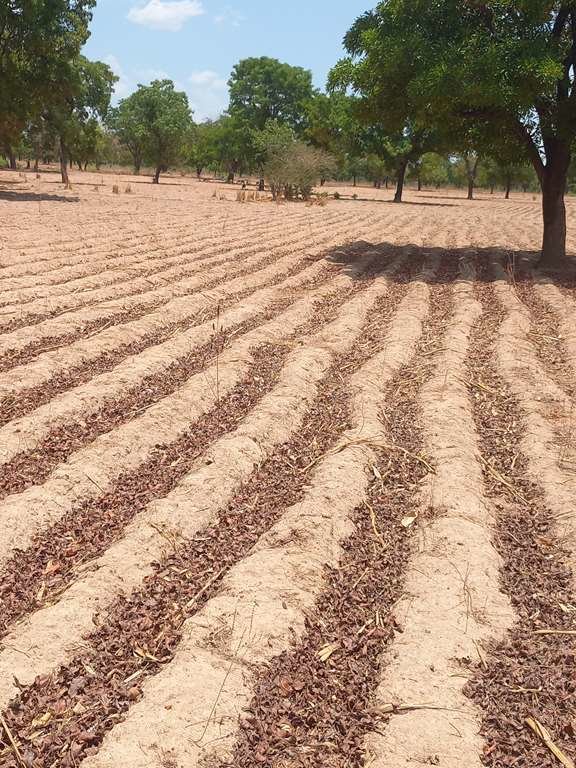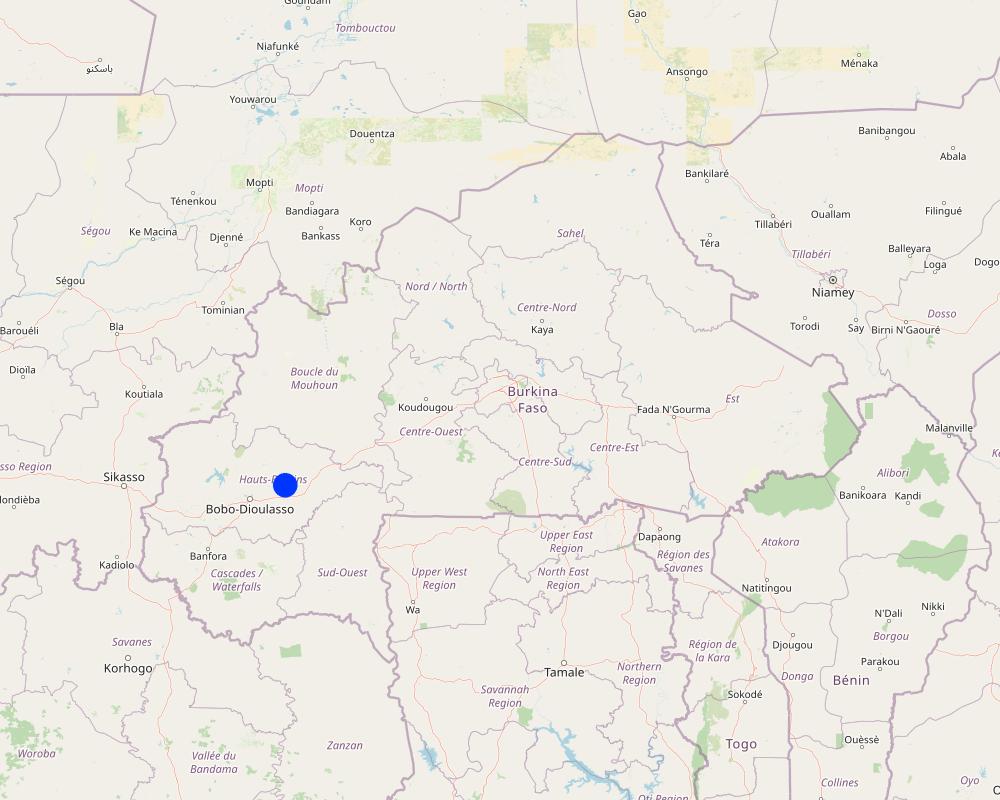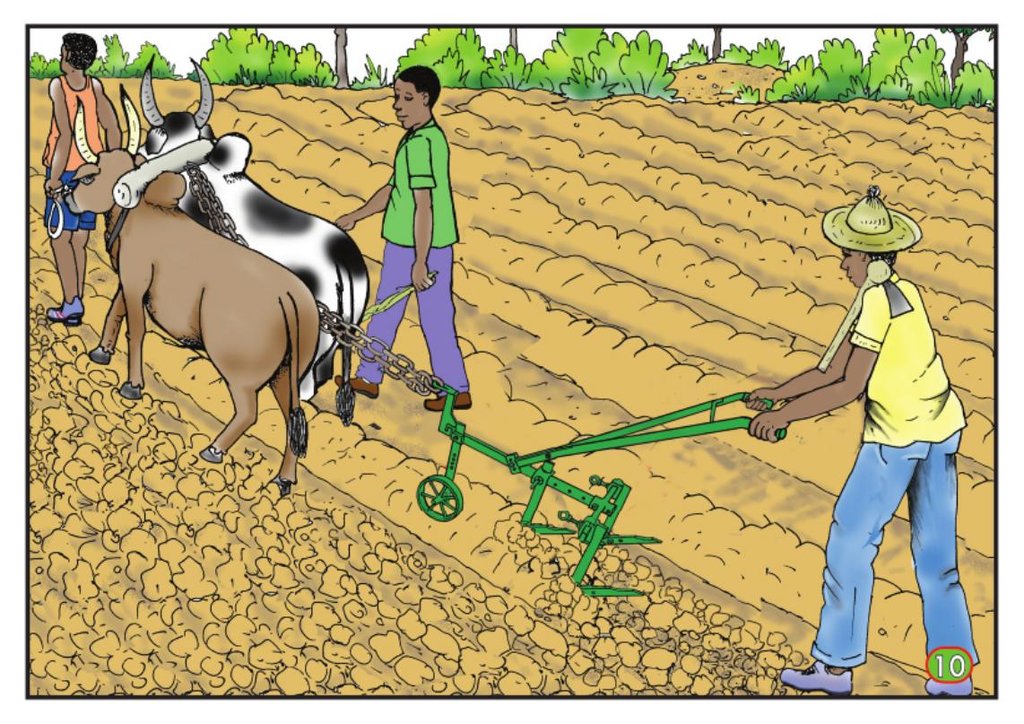Minimum Tillage [Burkina Faso]
- Creation:
- Update:
- Compiler: Moussa ABOU
- Editors: Siagbé Golli, Brice Sosthène BAYALA, Tabitha Nekesa, Ahmadou Gaye
- Reviewers: Sally Bunning, Rima Mekdaschi Studer, William Critchley
Walan tchi
technologies_6731 - Burkina Faso
View sections
Expand all Collapse all1. General information
1.2 Contact details of resource persons and institutions involved in the assessment and documentation of the Technology
Key resource person(s)
land user:
MILLOGO Issoufou
Name of project which facilitated the documentation/ evaluation of the Technology (if relevant)
Soil protection and rehabilitation for food security (ProSo(i)l)Name of the institution(s) which facilitated the documentation/ evaluation of the Technology (if relevant)
Deutsche Gesellschaft für Internationale Zusammenarbeit (GIZ)1.3 Conditions regarding the use of data documented through WOCAT
The compiler and key resource person(s) accept the conditions regarding the use of data documented through WOCAT:
Yes
1.4 Declaration on sustainability of the described Technology
Is the Technology described here problematic with regard to land degradation, so that it cannot be declared a sustainable land management technology?
No
2. Description of the SLM Technology
2.1 Short description of the Technology
Definition of the Technology:
Minimum tillage consists of working the soil superficially using a tined plough to scarify it and break up the previous year's ridges. This is a soil preparation technique that consists of not turning over the soil, which is a key principle of conservation agriculture.
2.2 Detailed description of the Technology
Description:
Minimum tillage prevents the degradation of soil structure, the loss of organic matter and soil biodiversity, while maintaining and restoring soil fertility. Thereby it fosters optimal conditions for crop growth and development while contributing to climate change adaptation and mitigation. In this case study, the technology involves surface-level soil manipulation using a tined implement, which can be pulled by either animal traction or a tractor. The adjustable tine, typically attached to a multi-cultivator or plough, aids in de-compacting and loosening the surface layer of the soil, a process feasible in both "dry" or "pre-wet" conditions. In this instance, draft oxen equipped with a single-tooth plough were employed, enabling the preparation of ten hectares annually. Alternatively, for farmers lacking oxen and equipment, rental options are available, typically ranging from 12,500 to 15,000 FCFA per hectare.
This minimum tillage approach involves scarifying sandy or stony soils - a swift soil preparation method typically targeting the upper five centimetres. This technique, performed with tools like the manga hoe or toothed triangle, does not involve soil inversion but effectively destroys weeds and prepares the seedbed, breaking up the previous year's ridges with one or more tines, reaching a maximum depth of 15 centimetres. Ridge spacing can vary from 50 to 70 centimetres based on the crop type.
These methods contribute to soil loosening, while mitigating the exposure and mineralization of soil organic matter. They facilitate enhanced retention and infiltration of early rainfall, thereby improving the soil water profile during the growing season. Consequently, the soil is less susceptible to erosive runoff effects while also bolstering mineral and water resources at the beginning of the crop cycle. This technology limits weed infestations through weed control and promotes the decomposition of plant residues and surface amendments by soil organisms. Key activities associated with implementing this technology include stump removal and single-pass ridge breaking.
The main inputs required for minimum tillage are oxen and ploughs. To restore soil fertility more efficiently, the farmer employs crop rotation strategies such as cotton-maize-red sorghum and red sorghum-cotton-cotton-soybean-cowpea rotations. This is important as the plants have neither the same needs nor the same competitors. Weed control is achieved through hoeing and herbicide use. Utilizing a tine cultivator is faster and less labour-intensive than traditional ploughing, which involves soil inversion. In addition, they assert that besides minimizing soil disturbance, it enhances water infiltration in-field. Additionally, they contend that its capacity for water retention significantly increases the likelihood of plant survival during dry spells.
2.3 Photos of the Technology
2.5 Country/ region/ locations where the Technology has been applied and which are covered by this assessment
Country:
Burkina Faso
Region/ State/ Province:
Hauts-Bassins region/Houet province/Léna commune
Further specification of location:
Kofila
Specify the spread of the Technology:
- applied at specific points/ concentrated on a small area
Is/are the technology site(s) located in a permanently protected area?
No
Map
×2.6 Date of implementation
Indicate year of implementation:
2015
If precise year is not known, indicate approximate date:
- less than 10 years ago (recently)
2.7 Introduction of the Technology
Specify how the Technology was introduced:
- through land users' innovation
3. Classification of the SLM Technology
3.1 Main purpose(s) of the Technology
- improve production
- reduce, prevent, restore land degradation
- create beneficial economic impact
3.2 Current land use type(s) where the Technology is applied
Land use mixed within the same land unit:
Yes
Specify mixed land use (crops/ grazing/ trees):
- Agroforestry

Cropland
- Annual cropping
- Tree and shrub cropping
Tree and shrub cropping - Specify crops:
- karite (sheanut)
- Néré
Number of growing seasons per year:
- 1
Is intercropping practiced?
No
Is crop rotation practiced?
Yes
If yes, specify:
Cotton, maize, red sorghum. Red sorghum, cotton; Cotton, soybean, cowpea.
3.3 Has land use changed due to the implementation of the Technology?
Has land use changed due to the implementation of the Technology?
- No (Continue with question 3.4)
3.4 Water supply
Water supply for the land on which the Technology is applied:
- rainfed
3.5 SLM group to which the Technology belongs
- rotational systems (crop rotation, fallows, shifting cultivation)
- minimal soil disturbance
3.6 SLM measures comprising the Technology

agronomic measures
- A3: Soil surface treatment
A3: Differentiate tillage systems:
A 3.2: Reduced tillage (> 30% soil cover)
3.7 Main types of land degradation addressed by the Technology

soil erosion by water
- Wt: loss of topsoil/ surface erosion

soil erosion by wind
- Et: loss of topsoil

biological degradation
- Bq: quantity/ biomass decline
3.8 Prevention, reduction, or restoration of land degradation
Specify the goal of the Technology with regard to land degradation:
- reduce land degradation
4. Technical specifications, implementation activities, inputs, and costs
4.1 Technical drawing of the Technology
Technical specifications (related to technical drawing):
Ridge spacing: 50 to 70 cm;
Cattle plough;
Draft oxen.
Author:
ProSoil
Date:
2020
4.2 General information regarding the calculation of inputs and costs
Specify how costs and inputs were calculated:
- per Technology area
Indicate size and area unit:
Hectare
Specify currency used for cost calculations:
- USD
If relevant, indicate exchange rate from USD to local currency (e.g. 1 USD = 79.9 Brazilian Real): 1 USD =:
598.7
Indicate average wage cost of hired labour per day:
CFA F 11,250
4.3 Establishment activities
| Activity | Timing (season) | |
|---|---|---|
| 1. | Stump removal | April |
| 2. | Ridging | May-June |
4.4 Costs and inputs needed for establishment
| Specify input | Unit | Quantity | Costs per Unit | Total costs per input | % of costs borne by land users | |
|---|---|---|---|---|---|---|
| Labour | Stump removal | Hectare | 1.0 | 6500.0 | 6500.0 | |
| Labour | Ridging | Hectare | 1.0 | 13750.0 | 13750.0 | |
| Equipment | Cattle plow | Number | 1.0 | 32000.0 | 32000.0 | |
| Other | Draft cattle | Nombre | 2.0 | 250000.0 | 500000.0 | |
| Total costs for establishment of the Technology | 552250.0 | |||||
| Total costs for establishment of the Technology in USD | 922.42 | |||||
4.5 Maintenance/ recurrent activities
| Activity | Timing/ frequency | |
|---|---|---|
| 1. | Weeding | June-July |
| 2. | Application of fertilizers | June-July |
| 3. | Application of herbicides | June-July |
4.6 Costs and inputs needed for maintenance/ recurrent activities (per year)
| Specify input | Unit | Quantity | Costs per Unit | Total costs per input | % of costs borne by land users | |
|---|---|---|---|---|---|---|
| Labour | Weeding | Hectare | 1.0 | 7500.0 | 7500.0 | |
| Labour | Application of fertilizers | Hectare | 2.0 | 5000.0 | 10000.0 | |
| Fertilizers and biocides | NPK | Bag | 3.0 | 27500.0 | 82500.0 | 100.0 |
| Fertilizers and biocides | Urea | Bag | 4.0 | 30000.0 | 120000.0 | 100.0 |
| Fertilizers and biocides | Pesticides | Jerrycan | 2.0 | 3700.0 | 7400.0 | 100.0 |
| Total costs for maintenance of the Technology | 227400.0 | |||||
| Total costs for maintenance of the Technology in USD | 379.82 | |||||
Comments:
Information on urea and NPK quantities relates to maize production. These are quantities calculated per hectare. For herbicides, the dose is three liters per hectare, with two applications per crop year.
4.7 Most important factors affecting the costs
Describe the most determinate factors affecting the costs:
The most important factor affecting costs is the availability of labor and fluctuating agricultural input prices. For example, a bottle of pesticide, which used to cost CFA F 2,250 over the last few years, now costs CFA F 3,700.
5. Natural and human environment
5.1 Climate
Annual rainfall
- < 250 mm
- 251-500 mm
- 501-750 mm
- 751-1,000 mm
- 1,001-1,500 mm
- 1,501-2,000 mm
- 2,001-3,000 mm
- 3,001-4,000 mm
- > 4,000 mm
Specify average annual rainfall (if known), in mm:
900.00
Specifications/ comments on rainfall:
The climate of the Hauts-Bassins region where the village of Kofila (commune of Lèna) is located is a tropical North-Sudanese and South-Sudanese climate. It is marked by two (02) main seasons: a wet season lasting 06 to 07 months (May to October/November) and a dry season lasting 05 to 06 months (November/December to April). Annual rainfall is relatively abundant, ranging from 800 to 1,200 mm.
Indicate the name of the reference meteorological station considered:
Léna Rainfall Station
Agro-climatic zone
- sub-humid
Average temperatures vary between 24°c and 30°c, with a relatively small temperature range of 5°c.
5.2 Topography
Slopes on average:
- flat (0-2%)
- gentle (3-5%)
- moderate (6-10%)
- rolling (11-15%)
- hilly (16-30%)
- steep (31-60%)
- very steep (>60%)
Landforms:
- plateau/plains
- ridges
- mountain slopes
- hill slopes
- footslopes
- valley floors
Altitudinal zone:
- 0-100 m a.s.l.
- 101-500 m a.s.l.
- 501-1,000 m a.s.l.
- 1,001-1,500 m a.s.l.
- 1,501-2,000 m a.s.l.
- 2,001-2,500 m a.s.l.
- 2,501-3,000 m a.s.l.
- 3,001-4,000 m a.s.l.
- > 4,000 m a.s.l.
Indicate if the Technology is specifically applied in:
- not relevant
Comments and further specifications on topography:
The site under consideration is located at an altitude of 299 m.
5.3 Soils
Soil depth on average:
- very shallow (0-20 cm)
- shallow (21-50 cm)
- moderately deep (51-80 cm)
- deep (81-120 cm)
- very deep (> 120 cm)
Soil texture (topsoil):
- coarse/ light (sandy)
- fine/ heavy (clay)
Soil texture (> 20 cm below surface):
- coarse/ light (sandy)
- fine/ heavy (clay)
Topsoil organic matter:
- medium (1-3%)
If available, attach full soil description or specify the available information, e.g. soil type, soil PH/ acidity, Cation Exchange Capacity, nitrogen, salinity etc.
The soils in the area are predominantly tropical ferruginous soils with minimal or no leaching, and mostly deep hydromorphic (waterlogged) soils (over 100 cm deep). The sandy-clay nature of these soils makes them sensitive to water erosion.
5.4 Water availability and quality
Ground water table:
5-50 m
Availability of surface water:
good
Water quality (untreated):
poor drinking water (treatment required)
Water quality refers to:
both ground and surface water
Is water salinity a problem?
No
Is flooding of the area occurring?
No
5.5 Biodiversity
Species diversity:
- medium
Habitat diversity:
- medium
5.6 Characteristics of land users applying the Technology
Sedentary or nomadic:
- Sedentary
Market orientation of production system:
- mixed (subsistence/ commercial)
Off-farm income:
- less than 10% of all income
Relative level of wealth:
- average
Individuals or groups:
- individual/ household
Level of mechanization:
- animal traction
Gender:
- men
Age of land users:
- middle-aged
5.7 Average area of land used by land users applying the Technology
- < 0.5 ha
- 0.5-1 ha
- 1-2 ha
- 2-5 ha
- 5-15 ha
- 15-50 ha
- 50-100 ha
- 100-500 ha
- 500-1,000 ha
- 1,000-10,000 ha
- > 10,000 ha
Is this considered small-, medium- or large-scale (referring to local context)?
- medium-scale
Comments:
The village of Kofila is a major cotton-producing area. Some farmers produce cotton over large expanses of land that can exceed 50 hectares.
5.8 Land ownership, land use rights, and water use rights
Land ownership:
- individual, not titled
Land use rights:
- leased
Water use rights:
- open access (unorganized)
Are land use rights based on a traditional legal system?
Yes
Specify:
Due to the sacred nature of the land, custom dictates that its management must not be subject to speculation
Comments:
Beyond the legal procedure for acquiring land, whereby a land title is granted, which is rarely applied, land tenure practices in the villages are guided by local habits and customs. Other common ways of accessing land in the village of Kofila are essentially through inheritance and borrowing. The other modes of access (lending, leasing and buying) do not appear to be common practice, nor a perceptible reality.
5.9 Access to services and infrastructure
health:
- poor
- moderate
- good
education:
- poor
- moderate
- good
technical assistance:
- poor
- moderate
- good
employment (e.g. off-farm):
- poor
- moderate
- good
markets:
- poor
- moderate
- good
energy:
- poor
- moderate
- good
roads and transport:
- poor
- moderate
- good
drinking water and sanitation:
- poor
- moderate
- good
financial services:
- poor
- moderate
- good
6. Impacts and concluding statements
6.1 On-site impacts the Technology has shown
Socio-economic impacts
Production
crop production
crop quality
Income and costs
expenses on agricultural inputs
Comments/ specify:
Fluctuating agricultural input prices in recent years have led to increased spending on agricultural inputs. On the other hand, the maintenance of plant residues on farms, combined with crop rotation, will further contribute to restoring soil organic matter and biodiversity. This in turn will reduce input costs and pesticide use.
farm income
Comments/ specify:
The combination of crop rotation, mineral fertilizers and pesticides has made it possible to increase agricultural income.
Ecological impacts
Water cycle/ runoff
harvesting/ collection of water
surface runoff
evaporation
Soil
soil moisture
soil cover
soil loss
soil compaction
nutrient cycling/ recharge
soil organic matter/ below ground C
Biodiversity: vegetation, animals
biomass/ above ground C
plant diversity
animal diversity
beneficial species
habitat diversity
Climate and disaster risk reduction
emission of carbon and greenhouse gases
wind velocity
6.2 Off-site impacts the Technology has shown
Specify assessment of off-site impacts (measurements):
No impact off-site
6.3 Exposure and sensitivity of the Technology to gradual climate change and climate-related extremes/ disasters (as perceived by land users)
Gradual climate change
Gradual climate change
| Season | increase or decrease | How does the Technology cope with it? | |
|---|---|---|---|
| annual temperature | increase | not well | |
| annual rainfall | decrease | not well |
6.4 Cost-benefit analysis
How do the benefits compare with the establishment costs (from land users’ perspective)?
Short-term returns:
positive
Long-term returns:
positive
How do the benefits compare with the maintenance/ recurrent costs (from land users' perspective)?
Short-term returns:
positive
Long-term returns:
very positive
6.5 Adoption of the Technology
- > 50%
Of all those who have adopted the Technology, how many did so spontaneously, i.e. without receiving any material incentives/ payments?
- 51-90%
6.6 Adaptation
Has the Technology been modified recently to adapt to changing conditions?
No
6.7 Strengths/ advantages/ opportunities of the Technology
| Strengths/ advantages/ opportunities in the land user’s view |
|---|
| Minimum tillage makes farming easier, saving time for farmers. |
| This technology promotes improved water retention. |
| Strengths/ advantages/ opportunities in the compiler’s or other key resource person’s view |
|---|
| Minimum tillage improves infiltration of runoff water. |
| Minimum tillage helps reduce soil degradation, erosion and runoff. |
6.8 Weaknesses/ disadvantages/ risks of the Technology and ways of overcoming them
| Weaknesses/ disadvantages/ risks in the land user’s view | How can they be overcome? |
|---|---|
| Minimal tillage means more careful weed control. | Intensify weed control. |
| Weaknesses/ disadvantages/ risks in the compiler’s or other key resource person’s view | How can they be overcome? |
|---|---|
| Minimal tillage requires the use of draft animals and tined implements. | Reduce the use of this technology. |
7. References and links
7.1 Methods/ sources of information
- field visits, field surveys
1
- interviews with land users
1
- interviews with SLM specialists/ experts
1
- compilation from reports and other existing documentation
4
When were the data compiled (in the field)?
04/25/2023
7.2 References to available publications
Title, author, year, ISBN:
Catalogue de fiches techniques des mesures d’amélioration de la fertilité des sols, Projet « Réhabilitation et protection des sols dégradés et renforcement des instances foncières locales dans les zones rurales du Burkina Faso » (ProSol), 2020/A catalog of data sheets on soil fertility improvement measures, under the project entitled "Rehabilitation and protection of degraded soils and strengthening of local land tenure bodies in the rural areas of Burkina Faso" (ProSol), 2020
Available from where? Costs?
Available at ProSol-Burkina Faso
Title, author, year, ISBN:
Diagnostic sur les sites d’extension de quatre (04) micros bassins versants au profit du ProSol, Projet « Réhabilitation et protection des sols dégradés et renforcement des instances foncières locales dans les zones rurales du Burkina Faso » (ProSol), 2020/A diagnostic assessment of the extension sites of four (04) micro-catchment areas for the ProSol project, "Rehabilitation and protection of degraded soils and strengthening of local land tenure bodies in the rural areas of Burkina Faso" (ProSol), 2020
Available from where? Costs?
Available at ProSol-Burkina Faso
Title, author, year, ISBN:
Étude sur l’analyse coûts-bénéfices et économiques des mesures CES/DRS promues par ProSol, Projet « Réhabilitation et protection des sols dégradés et renforcement des instances foncières locales dans les zones rurales du Burkina Faso » (ProSol), 2020/A study on the cost-benefit and economic analysis of the WSC/SDR measures promoted by ProSol, under the project entitled "Rehabilitation and protection of degraded soils and strengthening of local land tenure bodies in the rural areas of Burkina Faso" (ProSol), 2020
Available from where? Costs?
Available at ProSol-Burkina Faso
Title, author, year, ISBN:
Gestion Durable des Terres (GDT) sensible genre, Projet « Réhabilitation et protection des sols dégradés et renforcement des instances foncières locales dans les zones rurales du Burkina Faso » (ProSol), 2021/Gender-sensitive Sustainable Land Management (SLM), under the project entitled "Rehabilitation and protection of degraded soils and strengthening of local land tenure bodies in the rural areas of Burkina Faso" (ProSol), 2021
Available from where? Costs?
Available at ProSol-Burkina Faso
Links and modules
Expand all Collapse allLinks
No links
Modules
No modules


